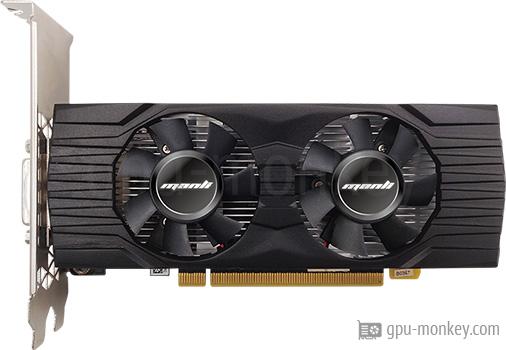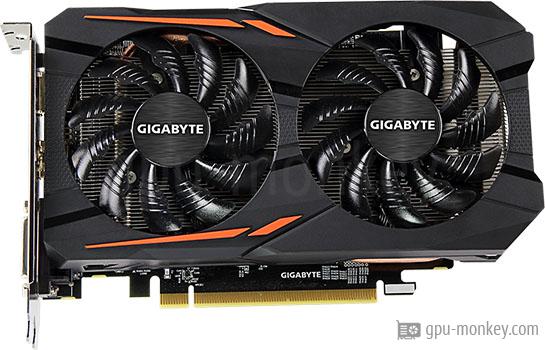Manli GeForce GTX 1630 Low Profile (M2471+N596)
vs
GIGABYTE Radeon RX 560 Gaming OC 4G (rev. 1.0)
GPU comparison with benchmarksThe Manli GeForce GTX 1630 Low Profile (M2471+N596) is based on the NVIDIA GeForce GTX 1630 (Turing) and has 4 GB GDDR6 graphics memory with a bandwidth of 96 GB/s.
The GIGABYTE Radeon RX 560 Gaming OC 4G (rev. 1.0) is based on the AMD Radeon RX 560 (16 CU) (GCN 4) and has 4 GB GDDR5 graphics memory with a bandwidth of 112 GB/s. |
||
GPUThe Manli GeForce GTX 1630 Low Profile (M2471+N596) has the TU117-150 graphics chip installed, which is based on the Turing architecture. The GIGABYTE Radeon RX 560 Gaming OC 4G (rev. 1.0) is based on the graphics chip Polaris 21 XT, which comes from the GCN 4 architecture. |
||
| Manli GeForce GTX 1630 Low Profile (M2471+N596) | GPU | GIGABYTE Radeon RX 560 Gaming OC 4G (rev. 1.0) |
| NVIDIA GeForce GTX 1630 | Based on | AMD Radeon RX 560 (16 CU) |
| TU117-150 | GPU Chip | Polaris 21 XT |
| Turing | Architecture | GCN 4 |
| 8 | Streaming Multiprocessors | 16 |
| 512 | Shader | 1024 |
| 16 | Render Output Units | 16 |
| 32 | Texture Units | 64 |
| 0 | Raytracing Cores | 0 |
MemoryThe graphics memory of the Manli GeForce GTX 1630 Low Profile (M2471+N596) clocks at 1.500 GHz, which corresponds to a speed of 12.0 Gbps. The graphics memory speed of the GIGABYTE Radeon RX 560 Gaming OC 4G (rev. 1.0) is 7.0 Gbps and the clock speed is 1.750 GHz. |
||
| 4 GB | Memory Size | 4 GB |
| GDDR6 | Memory Type | GDDR5 |
| 1.500 GHz | Memory Clock | 1.750 GHz |
| 12.0 Gbps | Memory Speed | 7.0 Gbps |
| 96 GB/s | Memory bandwidth | 112 GB/s |
| 64 bit | Memory Interface | 128 bit |
Clock SpeedsThe clock frequency of a graphics card determines the speed in connection with the graphics architecture. |
||
| 1.740 GHz | Base Clock | 1.199 GHz |
| 1.785 GHz | Boost Clock | 1.300 GHz |
| Avg (Game) Clock | 1.29 GHz | |
| Yes | Overclocking | Yes |
Thermal DesignThe Manli GeForce GTX 1630 Low Profile (M2471+N596) is powered by connectors. The TDP (Thermal Design Power) of the graphics card is 75 W. The GIGABYTE Radeon RX 560 Gaming OC 4G (rev. 1.0) has 1 x 6-Pin PCIe power connectors that supply it with energy. The manufacturer specifies the TDP of the card as 75 W. |
||
| 75 W | TDP | 75 W |
| -- | TDP (up) | -- |
| 90 °C | Tjunction max | 97 °C |
| PCIe-Power | 1 x 6-Pin | |
Cooler & FansThe Manli GeForce GTX 1630 Low Profile (M2471+N596) is equipped with a total of 2 Axial main fans. The GIGABYTE Radeon RX 560 Gaming OC 4G (rev. 1.0) has 2 Axial main fans that cool the GPU and memory. |
||
| Axial | Fan-Type | Axial |
| 2 x 50 mm | Fan 1 | 2 x 80 mm |
| -- | Fan 2 | -- |
| Air cooling | Cooler-Type | Air cooling |
| dB | Noise (Idle) | 0 dB |
| -- | Noise (Load) | -- |
ConnectivityUp to 3 screens can be operated with the Manli GeForce GTX 1630 Low Profile (M2471+N596). The GIGABYTE Radeon RX 560 Gaming OC 4G (rev. 1.0) supports the operation of a maximum of 4 monitors. |
||
| 3 | Max. Displays | 4 |
| 2.3 | HDCP-Version | 2.2 |
| 1x HDMI v2.0b | HDMI Ports | 1x HDMI v2.0b |
| 1x DP v1.4a | DP Ports | 1x DP v1.4 |
| 1 | DVI Ports | 1 |
| -- | VGA Ports | -- |
| -- | USB-C Ports | -- |
FeaturesetWith the Manli GeForce GTX 1630 Low Profile (M2471+N596) it is possible to operate a screen with a maximum resolution of up to 7680x4320 pixels. The maximum supported resolution of the GIGABYTE Radeon RX 560 Gaming OC 4G (rev. 1.0) is 5120x2880 pixels. |
||
| 7680x4320 | Max. resolution | 5120x2880 |
| 12_1 | DirectX | 12 |
| No | Raytracing | No |
| Yes | DLSS / FSR | Yes |
| No LED lighting | LED | No LED lighting |
Supported Video CodecsThe support and acceleration of certain video codecs can have a positive impact on the lower energy consumption and less waste heat from the graphics card. |
||
| Decode / Encode | h264 | Decode / Encode |
| Decode / Encode | h265 / HEVC | Decode / Encode |
| No | AV1 | No |
| Decode | VP8 | Decode |
| Decode | VP9 | Decode |
DimensionsThe Manli GeForce GTX 1630 Low Profile (M2471+N596) is connected to the system via PCIe 3.0 x 8 lanes and requires 2 PCIe-Slots space in the housing. The GIGABYTE Radeon RX 560 Gaming OC 4G (rev. 1.0) needs the space of 2 PCIe-Slots in the case and has a PCIe 3.0 x 8 Lanes interface. |
||
| 163 mm | Length | 190 mm |
| 78 mm | Height | 111 mm |
| 41 mm | Width | 37 mm |
| 2 PCIe-Slots | Width (Slots) | 2 PCIe-Slots |
| -- | Weight | -- |
| PCIe 3.0 x 8 | GPU Interface | PCIe 3.0 x 8 |
Additional dataThe Manli GeForce GTX 1630 Low Profile (M2471+N596) has been manufactured with a structure width of 12 nanometers since Q2/2022. The GIGABYTE Radeon RX 560 Gaming OC 4G (rev. 1.0) came on the market in Q2/2017 and will have a structure width of 14 nanometers manufactured. |
||
| M-NGTX1630/6RDLHDPLP-M2472 | Part-no | GV-RX560GAMING OC-4GD |
| Q2/2022 | Release date | Q2/2017 |
| 169 $ (Reference) | Launch Price | 99 $ (Reference) |
| 12 nm | Structure size | 14 nm |
| data sheet | Documents | data sheet |
Rate these graphics cards now
Benchmark results
3DMark Benchmark (DirectX, Raytracing)
3DMark is a benchmark program that determines the performance of certain components of a computer and then reports the performance as a numerical value.
Time Spy Extreme Graphics score
Battlefield 5
Battlefield 5 is a visually stunning game that is ideal as a graphics card benchmark. We test the game with maximum details on Windows 10.
3840x2160 (2160p)
2560x1440 (1440p)
1920x1080 (1080p)
Geekbench 6 (OpenCL, Vulkan, Metal)
Geekbench 6 is a cross-platform benchmark for main processors, which also carries out 3 different graphics benchmarks and outputs them in the form of a numerical value.
Geekbench 6 - OpenCL
|
|
Manli GeForce GTX 1630 Low Profile (M2471+N596)
4 GB GDDR6 |
||
|
|
GIGABYTE Radeon RX 560 Gaming OC 4G (rev. 1.0)
4 GB GDDR5 |
||
Geekbench 6 - Vulkan
|
|
Manli GeForce GTX 1630 Low Profile (M2471+N596)
4 GB GDDR6 |
||
|
|
GIGABYTE Radeon RX 560 Gaming OC 4G (rev. 1.0)
4 GB GDDR5 |
||
Geekbench 6 - Metal
FP32 Performance (Single-precision TFLOPS)
The theoretical computing power of the graphics card with single precision (32 bit) in TFLOPS indicates how many trillion FP32 floating point operations the graphics card (GPU) can perform per second.









